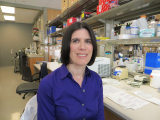Dissecting the Mechanism of Overgrowth and Tumorigenesis in Beckwith-Wiedemann Syndrome

Background
Beckwith-Wiedemann Syndrome (BWS) is a childhood overgrowth and cancer predisposition disorder due to changes on chromosome 11. Genetic changes similar to those observed in BWS are widespread and have been reported in isolated breast, pancreatic, adrenal, liver, renal, prostate, and colon cancers.
Project Goal
I propose to study BWS to understand the role of genetic dysregulation of chromosome 11 in growth during development and in tumor formation. The expression of several genes on chromosome 11 is altered in BWS patients and related cancers, and many other cancers, but previous BWS mouse models have not yet clarified a specific role for each of these genes. Therefore, this project will develop two distinct models to study the process of tumorigenesis caused by chromosome 11 alterations. First, I will develop a mouse model of the genetic alterations observed in BWS. Secondly, I will derive human cell lines from skin cells of BWS patients and reprogram them into the cell types in which cancers develop. This model will be the first human cell model of BWS. These models will provide unique resources to begin to decipher the genetic pathways dysregulated on chromosome 11 that lead to abnormal cell growth and ultimately cancer. Insights and management strategies gained from BWS research have the potential to help us understand many cancers and for the development of novel therapies for cancer.
Project Update
Jennifer Kalish answered questions about her research (August 2014).
What were you initially studying with your grant funded by ALSF?
I am studying Beckwith-Wiedemann syndrome (BWS), a cancer predisposition disorder. My goal is to understand why up to 1 in 4 children with BWS develop tumors. The genetic and/or epigenetic changes on chromosome 11 lead to BWS. These changes are seen in a number of isolated cancers, including cancers of the liver and kidney, but how these changes lead to cancer is not known. I am developing a novel mouse model and using cells from BWS patients to uncover how these genetic changes lead to tumors.
What have you found?
Having recognized that patients with both extreme and subtle forms of BWS develop tumors, I am using patient samples from both ends of this clinical spectrum to develop human cell-based models of BWS.
What does this mean for children with cancer and their families?
There is an association between genetic and epigenetic changes on chromosome 11 and cancer, but the specific pathways that lead from these genetic changes to tumor formation are unknown. Using these models to uncover these pathways will allow us to develop better ways of screening BWS patients for tumors and, ultimately, find potential treatments.
What are your next steps?
My next steps are to analyze these models for potential genes linking the genetic changes seen in BWS to tumors. Additionally, we are developing a registry of BWS patients to look at subtle features that may be predictive of risk for tumors.
What has this grant from ALSF allowed you to do that you wouldn’t have been able to do otherwise?
The ALSF grant has allowed me to develop the first human cell-based model of BWS, as well as a novel mouse model of BWS. These models will enable me to address how genetic changes on chromosome 11 lead to cancer in BWS patients. Furthermore, these models and the research they will generate have the potential to answer broader questions in epigenetics and cancer biology. The questions answered through ALSF’s funding of the models of BWS may help answer questions relating to other types of cancer as well.
Why did you choose to work in this field/on this topic?
At The Children’s Hospital of Philadelphia, we see many patients with BWS and at the moment all we can do is diagnose them and monitor them for tumor formation. We cannot offer them rational therapies or more specific monitoring. I saw a large gap in our knowledge about why these patients develop tumors and an absence of mouse or human cell models to address these questions. I chose this path in order to improve the care for children with BWS and related overgrowth syndromes. Developing and characterizing these models is a crucial first step. Furthermore, the genetic changes in BWS are also seen in a range of other cancers, suggesting the larger application of studying a rare genetic disease to the field of tumor biology.
Dr. Kalish, how did you benefit from being mentored during this project?
In order to launch an independent line of research, it is necessary to learn how to take a novel idea and, within the current framework of the field, apply techniques and forge innovative ways to approach the question. ALSF has provided me with the resources to do just that by supporting this new line of research.
Dr. Kalish's mentor on this project, Marisa Bartolomei, Ph.D. said:
There have been several benefits to mentoring Dr. Kalish. I provide scientific guidance to Dr. Kalish, while she provides me with clinical expertise. She has broadened my laboratory’s focus on the downstream clinical affect of epigenetic mechanisms and has brought the first human samples into my laboratory. Moreover, I am thrilled to mentor a young investigator like Dr. Kalish, to help her develop an independent line of research with novel disease models that applies many of the techniques we have used in the lab to an unsolved clinical question.

